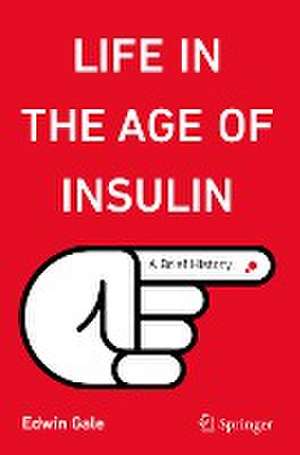Life in the Age of Insulin: A Brief History: Copernicus Books
Autor Edwin Galeen Limba Engleză Hardback – 30 ian 2024
It envisages a future of competitive insulin pricing and revolutionary therapies, kindling hope for health equity.
With over 70 million insulin users world-wide, this book bridges the gap for patients and families. It will appeal to health professionals, to those intrigued by science, and to anyone who likes a good story.
Life in the Age of Insulin is an empathetic and enlightening saga of science, society and human resilience.
Din seria Copernicus Books
- 5%
 Preț: 160.41 lei
Preț: 160.41 lei -
 Preț: 131.12 lei
Preț: 131.12 lei -
 Preț: 161.23 lei
Preț: 161.23 lei -
 Preț: 162.68 lei
Preț: 162.68 lei - 5%
 Preț: 123.81 lei
Preț: 123.81 lei -
 Preț: 136.09 lei
Preț: 136.09 lei - 5%
 Preț: 143.19 lei
Preț: 143.19 lei -
 Preț: 172.22 lei
Preț: 172.22 lei -
 Preț: 199.48 lei
Preț: 199.48 lei - 5%
 Preț: 125.14 lei
Preț: 125.14 lei -
 Preț: 123.27 lei
Preț: 123.27 lei - 5%
 Preț: 202.46 lei
Preț: 202.46 lei -
 Preț: 125.51 lei
Preț: 125.51 lei -
 Preț: 110.05 lei
Preț: 110.05 lei -
 Preț: 103.91 lei
Preț: 103.91 lei - 5%
 Preț: 103.98 lei
Preț: 103.98 lei -
 Preț: 132.16 lei
Preț: 132.16 lei
Preț: 165.50 lei
Preț vechi: 174.22 lei
-5% Nou
Puncte Express: 248
Preț estimativ în valută:
31.67€ • 34.39$ • 26.60£
31.67€ • 34.39$ • 26.60£
Carte disponibilă
Livrare economică 01-15 aprilie
Preluare comenzi: 021 569.72.76
Specificații
ISBN-13: 9783031471896
ISBN-10: 303147189X
Pagini: 270
Ilustrații: XXX, 270 p. 38 illus., 25 illus. in color.
Dimensiuni: 155 x 235 x 23 mm
Greutate: 0.7 kg
Ediția:1st ed. 2023
Editura: Springer Nature Switzerland
Colecția Springer
Seria Copernicus Books
Locul publicării:Cham, Switzerland
ISBN-10: 303147189X
Pagini: 270
Ilustrații: XXX, 270 p. 38 illus., 25 illus. in color.
Dimensiuni: 155 x 235 x 23 mm
Greutate: 0.7 kg
Ediția:1st ed. 2023
Editura: Springer Nature Switzerland
Colecția Springer
Seria Copernicus Books
Locul publicării:Cham, Switzerland
Cuprins
PART ONE: BEFORE THE DAWN (1889-1921).- PART TWO: FROM DISCOVERY TO THE DOLDRUMS (1922 to the 1960s).- PART THREE: TWO TYPES OF DIABETES (1930s – 1980s).- PART FOUR: THE SHAPE OF THINGS TO COME (1960s-1990s).- PART FIVE: MODERN TIMES (~1990 on).
Notă biografică
I am a retired specialist and researcher in diabetes, with >250 listed publications. I have edited or co-edited several books on diabetes and was responsible for the diabetes section of the first 7 editions of Kumar and Clarke, a successful student textbook of medicine. My first single-author book, The Species that Changed Itself, came out in Penguin in 2019. I was Editor-in-Chief of Diabetologia, the European Journal of Diabetes, between 2004-2011.
I chaired the Special Advisory Group on Endocrinology for EMA over a similar period. In 2017 I chaired the WHO Committee on Essential Medicines for Diabetes. Other tasks, awards etc are listed in my CV. I specialized in the clinical care of people with diabetes from 1965-2011, which has given me a ~50-year overview of the history of the subject. I knew many for the characters referred to in the book and interviewed some of them for it.
I chaired the Special Advisory Group on Endocrinology for EMA over a similar period. In 2017 I chaired the WHO Committee on Essential Medicines for Diabetes. Other tasks, awards etc are listed in my CV. I specialized in the clinical care of people with diabetes from 1965-2011, which has given me a ~50-year overview of the history of the subject. I knew many for the characters referred to in the book and interviewed some of them for it.
Textul de pe ultima copertă
Life in the Age of Insulin offers a straightforward and jargon-free narrative account of how insulin was discovered, what it does, why people still struggle to obtain it, and what the future might hold. It tells of the creative power that emerges when many people work towards a common goal, and of collective strength founded upon the limitations of individuals.
It envisages a future of competitive insulin pricing and revolutionary therapies, kindling hope for health equity.
With over 70 million insulin users world-wide, this book bridges the gap for patients and families. It will appeal to health professionals, to those intrigued by science, and to anyone who likes a good story.
Life in the Age of Insulin is an empathetic and enlightening saga of science, society and human resilience.
With over 70 million insulin users world-wide, this book bridges the gap for patients and families. It will appeal to health professionals, to those intrigued by science, and to anyone who likes a good story.
Life in the Age of Insulin is an empathetic and enlightening saga of science, society and human resilience.
Caracteristici
* Written by an acknowledged expert The only comparable history of insulin Of potential interest to health professionals and interested non-professionals alike
